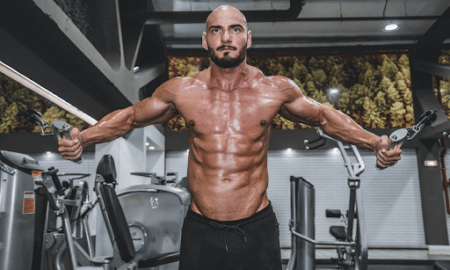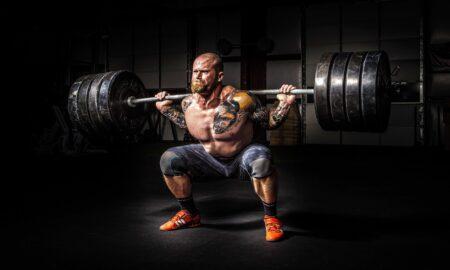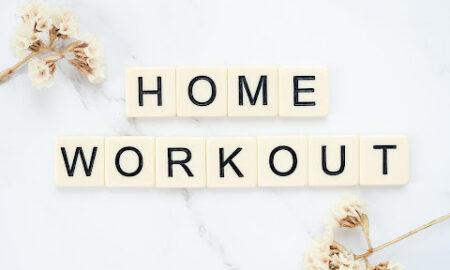 Q: I just finished reading your October ’08 column highlighting workouts for beginning bodybuilders. I found your advice timely, as I’m starting that journey myself, although with a big difference—I’m 52. I’ve lifted weights off and on over the years but have never been consistently serious until almost six years ago. At that time, I was 47, 6’5” and almost 250 pounds with 20-plus percent bodyfat. I started doing full-body workouts and slow-motion cardio. After almost three years and a couple of injuries that helped me learn how to be more careful, I was doing very well. My weight was down to 210 with about 12 percent bodyfat, according to my online trainer. I’d gone from a 90- to a 170-pound bench press for three sets of 12 reps, deadlifting 350, doing 24 to 30 sets per workout using a split routine, and although I never saw my abs and never really put on much mass, my waist was down to 36 inches. That was three years ago, November, 2005.
Q: I just finished reading your October ’08 column highlighting workouts for beginning bodybuilders. I found your advice timely, as I’m starting that journey myself, although with a big difference—I’m 52. I’ve lifted weights off and on over the years but have never been consistently serious until almost six years ago. At that time, I was 47, 6’5” and almost 250 pounds with 20-plus percent bodyfat. I started doing full-body workouts and slow-motion cardio. After almost three years and a couple of injuries that helped me learn how to be more careful, I was doing very well. My weight was down to 210 with about 12 percent bodyfat, according to my online trainer. I’d gone from a 90- to a 170-pound bench press for three sets of 12 reps, deadlifting 350, doing 24 to 30 sets per workout using a split routine, and although I never saw my abs and never really put on much mass, my waist was down to 36 inches. That was three years ago, November, 2005.
My daughter’s health took me away from training for almost three years, but she’s now on the mend. I’ve started training again and getting refocused. I can still bench-press 145 pounds for three sets of eight and deadlift 250 pounds. I’ve never made the commitment to be a real bodybuilder, but I’d like to do so now.
I’ve returned to an old full-body routine similar to one you suggested in your column. I’m doing three sets of 12 reps for a dozen exercises. My plan was to do that for two to three months while doing HIT cardio on off-days, then switch to the split routine you suggested.
I was amazed at the volume in your split routine. Is that really what I need to put on solid mass? What level of intensity is needed with that volume? Later in the same issue, C.S. Sloan, a former powerlifter, recommends lots of volume, staying away from failure and moderate reps (six to eight), while Steve Holman’s approach with X Reps and POF suggests less volume with extreme intensity, even for an older guy like me.
My question comes down to this: Can I apply the general outline of your article to my own training needs as a 52-year-old relative newbie? What general modifications, if any, would you recommend to ensure that it’s effective? Or would you recommend an alternative approach such as Sloan’s or Holman’s for someone in my situation?
A: I think it’s great that you’re making the commitment to be a “real bodybuilder.” It’s never too late, and I’m happy that you’re ready to take on the challenge and achieve your best condition ever.
The routine I listed in the October issue is an intermediate program designed for younger bodybuilders who are trying to add size and gain weight. That was the routine I used to bulk up when I was in my early 20s.
That program is centered on the basic exercises, using heavy resistance for six to eight reps. I trained each bodypart twice a week, but I trained only four days a week so I’d have three full days to recover. The volume is relatively high because I trained four muscle groups at each workout with an average of 10 to 12 sets per bodypart. Here’s the routine again:
Monday
Bench presses 4 x 10, 8, 6, 6
Incline dumbbell presses 3 x 8, 6, 6
Flyes 3 x 8, 6, 6
Dumbbell pullovers 3 x 10, 8, 8
Seated military presses 4 x 10, 8, 6, 6
Lateral raises 4 x 10, 8, 6, 6
Bent-over lateral raises 3 x 8, 6, 6
Barbell shrugs 4 x 10, 8, 6, 6
Pushdowns 4 x 10, 8, 6, 6
Lying triceps extensions 3 x 8, 6, 6
Weighted dips 3 x 8, 6, 6
Standing calf raises 4 x 12, 10, 8, 6
Seated calf raises 3 x 12, 10, 8
Tuesday
Incline situps 3 x max
Incline knee raises 3 x max
Squats 5 x 10, 8, 6, 6, 6
Leg presses 4 x 12, 10, 8, 6
Leg curls 4 x 10, 8, 6, 6
Stiff-legged deadlifts 3 x 10, 8, 6
Wide-grip chins 4 x 10, 8, 6, 6
Barbell rows 4 x 10, 8, 6, 6
Seated cable rows 3 x 10, 8, 6
Incline curls 3 x 10, 8, 6
Barbell curls 3 x 8, 6, 6
Wrist curls 4 x 12, 10, 8, 8
Wednesday
Rest
Thursday
Bench presses 4 x 10, 8, 6, 6
Incline barbell presses 3 x 8, 6, 6
Incline flyes 3 x 10, 8, 6
Weighted dips 3 x 8, 6, 6
Seated dumbbell presses 4 x 10, 8, 6, 6
Seated lateral raises 4 x 10, 8, 6, 6
Upright rows 3 x 10, 8, 6
Power cleans 3 x 8, 6, 6
Close-grip bench presses 4 x 10, 8, 6, 6
Seated barbell extensions 3 x 8, 6, 6
Donkey calf raises 4 x 20
Leg press calf raises 3 x 15, 12, 10
Friday
Incline situps 3 x max
Incline knee raises 3 x max
Squats 4 x 12, 10, 8, 8
Front squats 3 x 10, 8, 6
Leg curls 4 x 10, 8, 6, 6
Stiff-legged deadlifts 3 x 10, 8, 6
Wide-grip chins 4 x 12, 10, 8, 6
One-arm dumbbell rows 3 x 8, 6, 6
T-bar rows 4 x 10, 8, 6, 6
Hyperextensions 3 x 15-20
Seated dumbbell curls 3 x 10, 8, 6
Preacher curls 3 x 8, 6, 6
Wrist curls 4 x 12, 10, 8, 6
As we get older, recuperation plays a bigger role in our workouts. I’m in my mid-40s now, and I never train more than four days a week. I’ve modified the intermediate routine by training each bodypart only once instead of two times a week. That seems to help recuperation, not only for my muscles but also for my joints and tendons—a big consideration as we get older.
By training only two muscle groups per workout instead of four, I keep my total volume much lower. That makes it easier to train harder at each workout, and it gives me more days off before I train the same bodyparts again. I can no longer train each muscle group twice a week because I don’t recuperate as fast as I used to.
I think a good routine for you at your level would be to split your body up over three workouts. Don’t train three days in a row—you’ll need a day off after two consecutive days of workouts. Instead, train two days on/one day off. That will give you five days of rest for each muscle group and your body two to three complete days of rest per week. Here’s an example:
Day 1: Chest, arms, calves
Dumbbell bench presses 4 x 12, 10, 8, 6
Incline presses 3 x 10, 8, 6
Incline flyes 3 x 10, 8, 8
Close-grip bench presses 3 x 10, 8, 8
Lying extensions 3 x 10, 8, 6
Incline curls 3 x 10, 8, 8
Barbell curls 3 x 10, 8, 6
Seated calf raises 4 x 20, 15, 12, 10
Day 2: Abs, legs
Hanging knee raises 3 x 30-40
Crunches 3 x 30-40
Leg extensions 3 x 15, 12, 10
Leg presses 3 x 12, 10, 8
Squats 3 x 10, 8, 8
Leg curls 3 x 12, 10, 8
Stiff-legged deadlifts 3 x 10, 8, 8
Day 3: Off
Day 4: Delts, back, calves
Seated dumbbell presses 3 x 10, 8, 6
Lateral raises 3 x 10, 8, 8
Bent-over lateral raises 3 x 10, 8, 8
Shrugs 3 x 10, 8, 6
Wide-grip chins 3 x 12, 10, 8
Barbell rows 3 x 10, 8, 6
Deadlifts 3 x 10, 8, 6
Leg press calf raises 4 x 12, 10, 8, 8
Day 5: Off
Day 6: Repeat cycle
The program focuses on the basic exercises, but by training fewer bodyparts per workout, you cut way back on the volume. It should be a good routine for you. Keep training hard by making the workouts progressive—training heavier or employing techniques such as supersets or drop sets to increase the intensity—and you should be able to achieve your goal of getting into the best shape of your life.
Q: My calves, and a lot of other people’s, are extremely stubborn. I’ve noticed improvement recently, but not much. As the calves are fast-recovering muscles, would it be all right to hit them with four sets four times a week? I want to do a soleus-prominent day, then a gastrocnemius-prominent day, alternating between standing and seated calf raises. Any thoughts on that?
A: The calves are notorious for being the bodybuilder’s most challenging bodypart. The bodybuilders with the best calves usually owe much of their development to heredity. Chris Dickerson, Ken Waller, Mike Matarazzo and Mike Mentzer always credited their parents for their incredible calf development; however, many bodybuilders don’t put the effort into developing their calves that they do other muscles, like the chest, arms or even thighs. Another problem is the overwhelming opinion that if your calves are weak, it’s all genetics and there’s nothing you can do about it.
My calves were very skinny when I started bodybuilding as a teenager. My legs were a weak point, and I always worked hard on them to bring them into balance with my upper body. My calves eventually developed into one of my stronger bodyparts.
Calves seem to recuperate much more quickly than most muscle groups, so they need to be trained more than once a week. I work my calves with two exercises for three to four sets each, twice a week. I usually train them on Monday and Thursday, giving them three to four days of rest between workouts.
I think the best exercise for calves is the donkey calf raise. I love doing donkeys because the weight is distributed directly over the hips—unique for a calf exercise. In addition, donkey calf raises give you heavy resistance and higher repetitions.
The key to building the calves is to train them heavy and use high repetitions to really pump the blood into the muscle. If you think about it, the calf muscles are the farthest from the heart, so you have to do more repetitions to get the blood into the calves. Even so, you can’t train the calves with light weights and expect them to grow. The muscle fibers in the calves are accustomed to walking every day, so doing high reps with a light-to-moderate resistance won’t do the trick.
I do donkey calf raises with someone sitting on my back instead of using a machine. Most of the machines I’ve seen don’t have enough resistance to really develop the calves. In addition to the weight of my partner, I use a belt to strap on more weight.
At one point in my career, when I made the best gains in calf development, I had two guys sit on my back along with another 100 pounds in resistance hanging from the belt. I could force out 15 reps with that substantial weight—about 500 pounds—before one of the guys would jump off. I’d continue doing the exercise with just one guy on my back and the extra 100 pounds. I could usually get another 10 reps with that resistance before the other guy would jump off. Then, with just the weight from the belt, I’d force out another 10 reps. That amounted to a total of 35 reps.
By doing drop sets that way, I trained my calves with very heavy weight but still did a lot of repetitions to force the blood into the muscle. The combination of high resistance and high reps really made the difference in building up my calves.
My current program has me working calves on Monday, doing seated calf raises—the best exercise for developing the soleus—for four sets of 10 to 20 reps followed by standing calf raises for the gastrocs, three to four sets of eight to 12 reps.
I use high reps on the seated calf raises because the soleus is composed mostly of slow-twitch fibers, and it responds best to high repetitions—15 to 20. After I have the blood in the muscle, I move to standing calf raises. I use heavier weights for eight to 12 reps to develop the fast-twitch muscle fibers of the gastrocnemius.
On Thursday I begin with donkey calf raises for four sets of 20 to 30 reps. That blows up my calves and gives me a great pump. When I finish the four sets, I can hardly walk. I finish off with another three sets of calf raises on the leg press machine, keeping my knees straight and getting a full range of motion—three sets of 10 to 12 reps.
You can see the pattern here. Do high reps with the first exercise to get a great pump in your calves and then follow up with another exercise that uses heavier resistance. The combination is the best for developing size in the calves.
Editor’s note: John Hansen has won the Mr. Natural Olympia and is a two-time Natural Mr. Universe winner. Check out his Web site at www.NaturalOlympia.com or send questions or comments to him via e-mail at [email protected]. Look for John’s new DVD, “Natural Bodybuilding Seminar and Competitions,” along with his book, Natural Bodybuilding, and his training DVD, “Real Muscle,” at his Web site or at Home Gym Warehouse, www.Home-Gym.com. Send written correspondence to John Hansen, P.O. Box 3003, Darien, IL 60561. IM




















You must be logged in to post a comment Login